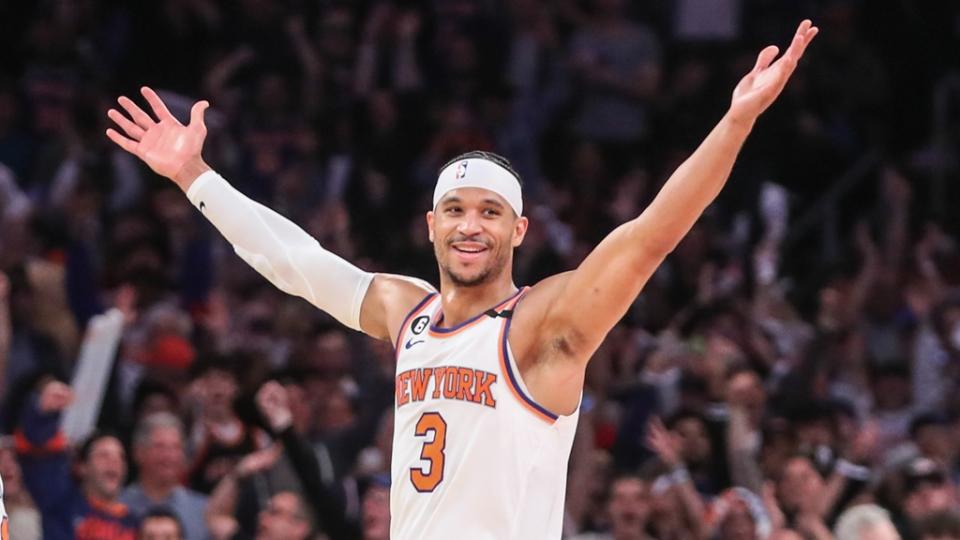What’s next for Knicks after finalizing Josh Hart’s extension?

Six months ago, Josh Hart walked into the press conference room at Madison Square Garden and delivered a clear message: “I'm looking for a home, and I think this could be it.”
Hart was talking to the media on his first day as a Knick. A few hours later, he had 11 points, seven rebounds (four offensive), four steals and four assists in a win over Utah.
Those results continued for both Hart and the Knicks; New York went 17-8 when he was in the lineup in the regular season. He hit a game-clinching shot in the Knicks’ Game 2 win over Cleveland, a victory that propelled them to a series win.
It didn’t take long to realize that Hart and New York were destined for a long-term partnership.
That partnership will be solidified on Thursday when Hart signs a four-year extension with the Knicks. The deal, first reported by ESPN, will be worth roughly $81 million. It will be tacked on to the final season of his current contract. In total, Hart will be under contract for five years with the Knicks and will make roughly $94 million.
The length and total amount of the deal tells you all you need to know about the way the Knicks value Hart.
Is $18 million per year fair value?
Some Knick fans might have experience sticker shock when they saw the amount of the deal. Hart will make an average of $18.6 million per season over the next five years. If that seems like a lot of money, it is. But the salary cap is projected to rise over the next few seasons due in part to a new television contract. So it’s instructive to view Hart’s deal as a percentage of the salary cap as opposed to an isolated dollar figure.
As ESPN Front Office Insider Bobby Marks notes, Hart will not earn more than 14 percent of the salary cap in any season of his deal.
That figure aligns well for a player who projects to play starter’s minutes and had an undeniable impact on winning last season.
So the contract will look more and more team-friendly as time passes.
Obviously, no one will care about the percentage of the cap on Hart’s deal if the Knicks fail to contend over the life of his contract. But if the team continues to win and contends in the Eastern Conference, Hart’s deal will look like a win for both team and player. Lastly, we don’t know yet if the contract is fully guaranteed. I would assume that all years are guaranteed but some of the $81 million is tied into performance bonuses.
What's next?
Immanuel Quickley’s extension. The deadline for Quickley to extend is on the eve of the 2023-24 regular season. So both sides have plenty of time to come to an agreement. It would be odd if the Knicks let Quickley enter the season as a 2024 restricted free agent. In that scenario, New York would risk losing Quickley for nothing if he signed an offer sheet that the Knicks declined to match.
If the Knicks and Quickley agree to an extension, New York would have seven rotation players under contract through at least 2024-25.
The money New York spent on Hart shouldn’t have a significant impact on what the club would offer Quickley. Both extensions begin in 2024-25. New York will have to deal with the luxury tax if it commits significant money to Quickley. But team governor James Dolan has never shied away from spending luxury tax money in the past. If this Knicks team remains competitive, I can’t see luxury tax payments prohibiting them from spending how they see fit.
What about this season?
The Knicks are hard-capped at the first apron this season. So they can’t spend more than $172 million in team salary. They are roughly $6.6 million shy of the first apron at the moment. That number is worth noting if you are wondering whether the Knicks will sign any other free agents in the offseason (particularly at backup power forward).
With Hart signed to an extension, he can not be traded until the 2024 offseason. So you shouldn’t include Hart in any 2024 trade deadline hypotheticals.
If Quickley signs an extension, his contract becomes difficult to trade in its first year. So you should also take that into account in any hypothetical trade scenarios. Quickley’s contract becomes more traditional for trade purposes at the start of the 2024-25 calendar year.

